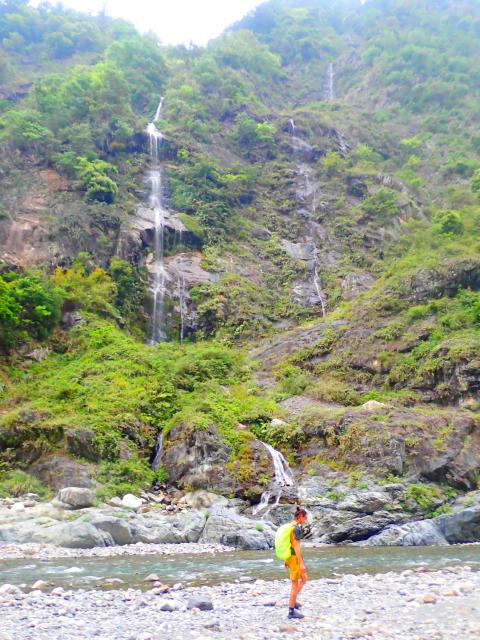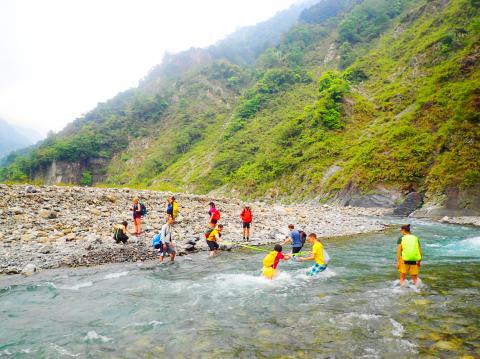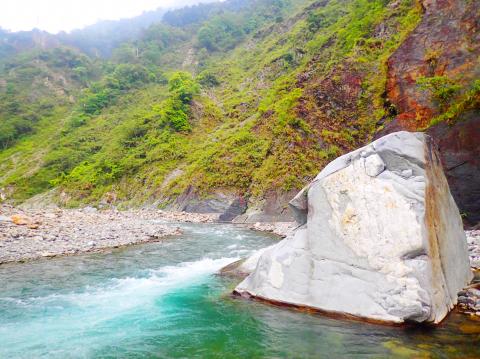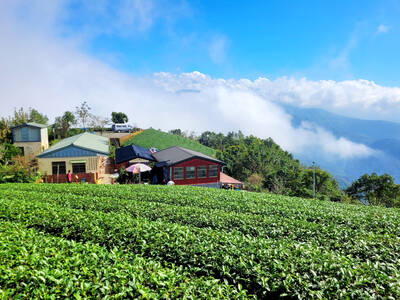The beautiful Central Cross-island Highway (Highway No. 8), which once linked the cities of Taichung on the flat western plains of Taiwan, and Hualien, below the towering mountains and sea cliffs of the island’s east coast is, like its two counterparts (the North and South Cross-island Highways) graced with several fabulous undeveloped hot spring sources.
Best known by far is Wenshan Hot Spring (文山溫泉), nestling in the depths of a stunning marble canyon at the head of Hualien County’s Taroko Gorge. It’s easily Taiwan’s most famous and popular undeveloped hot spring, and a compulsory part of any trip to the gorge.
Reopened to the public a few years ago after being closed during the early years of the millennium following a rockfall, the hot springs are currently closed once again, although some visitors do walk round the barrier and take an illegal bathe.

Photo: Richard Saunders
REMINDERS OF 921
Across the mountains near the western end of the highway, Taichung’s Kukuan Hot Springs (谷關溫泉) were first developed during the Japanese colonial era, and today most of the hot spring sources have been tapped to supply the many bath houses and resort spas around the village. Unfortunately, getting from Taroko Gorge to Kukuan these days involves a very long detour south. The section of highway between Kukuan and Tehchi (德基) is currently still closed after it was destroyed by the 921 Earthquake in 1999.
There are rumors that the highway could — finally — reopen in the next year or so, but don’t hold your breath: similar announcements have been made in the past.

Photo: Richard Saunders
Most nature lovers visit the Kukuan area to climb one or more of the Seven Heroes (谷關七雄), a septet of fine mountains reached by scenic, if quite strenuous, trails. However, one hot spring source several kilometers east of the village has remained beautiful and completely undeveloped, and is the goal of an exceptionally scenic half-day hike. This is Maling Hot Spring (馬陵野溪溫泉).
The hot spring was buried by a landslide caused by the 921 earthquake, and only resurfaced a decade later. Even today summer flood waters sometimes bury the hot spring sources for short periods.
SPECTACULAR GORGE AND WATERFALLS

Photo: Richard Saunders
The makeshift pools of Maling Hot Spring (made by heaping shingle in the riverbed into low “walls” to trap the hot water) are great for a soak, but the real attraction of a visit is to enjoy the magnificent scenery on the way there. The trip isn’t long (allow 1.5 to 2 hours each way), but runs through a deep gorge with tall cliffs and several impressive waterfalls.
The jumping-off point for Maling Hot Spring is a dusty track veering left off Highway No. 8, three kilometers east of Kukuan police station. The track descends toward the river bank, but soon stops at a gate. Squeeze round the side of it and walk down to the water’s edge. The gate is there for a good reason — the reservoir upstream periodically releases water, sending down flood waters which could be dangerous for anyone wading in the river at the time. This is most likely during the summer wet season, when the river will be flowing deep and fast, and the hot springs will be inaccessible anyway.
Take care if you go, and don’t, as some people do, camp the night on the river bank.

Photo: Richard Saunders
Once down at the river, start walking upstream, wading through the water or following the wide banks of exposed rock and gravel. Crossing the river can be quite a challenge if it’s rained recently. Don’t attempt the trip if there’s been heavy rain, and if the first crossing is difficult — give up and turn back.
After a short walk a fine waterfall drops from the cliffs on the right into the gorge: the first of several magnificent waterfalls on the route. It’s actually not quite the natural feature it at first appears to be. In fact it’s a remnant of the old electricity power station that stood here until 1999, and the water emerges from a concealed pipe, but it’s no less beautiful for that.
HOT SPRINGS
Now simply continue wading and clambering upstream, past a structure resembling an ornate temple built into the sheer cliff. It’s the entrance to the former power plant; the rest of the structure was destroyed during the 921 earthquake.
Eventually the first of several tall (natural) waterfalls plunge down the sides of the gorge, making a magnificent addition to the wild scenery. The first fall, on the left side, signals that the hot spring isn’t much further.
The hot springs are beside the left bank of the river. Look for pools scooped out by other visitors to indicate where they are. On our visit, heavy rains a week or two earlier had practically buried them in gravel, although we found some pools of lukewarm water just above the level of the swirling river. They’d be a wonderful spot for a soak in winter, but as already mentioned, the great attraction of a visit to Maling Hot Spring is in the adventure to get there, and the great beauty of the gorge.
Maling Hot Spring is far less popular than the Kukuan Seven Heroes nearby, but is every bit as deserving of a visit. Even better, spend a weekend in the area, climb one of the summits on Saturday, and spend a more relaxing second day visiting Maling, to soak those tired muscles.
IF YOU GO
The nearest bus service terminates at Kukuan, three kilometers from the start of the river trace up to the hot spring. Regular buses serve the village from Taichung’s Fongyuan District (豐原), which has a stop operated by the Taiwan Railways Administration. Get off at the final stop, in the center of Kukuan.
Richard Saunders is a classical pianist and writer who has lived in Taiwan since 1993. He’s the founder of a local hiking group, Taipei Hikers, and is the author of six books about Taiwan, including Taiwan 101 and Taipei Escapes. Visit his Web site at www.taiwanoffthebeatentrack.com.

In recent weeks the Trump Administration has been demanding that Taiwan transfer half of its chip manufacturing to the US. In an interview with NewsNation, US Secretary of Commerce Howard Lutnick said that the US would need 50 percent of domestic chip production to protect Taiwan. He stated, discussing Taiwan’s chip production: “My argument to them was, well, if you have 95 percent, how am I gonna get it to protect you? You’re going to put it on a plane? You’re going to put it on a boat?” The stench of the Trump Administration’s mafia-style notions of “protection” was strong

Every now and then, it’s nice to just point somewhere on a map and head out with no plan. In Taiwan, where convenience reigns, food options are plentiful and people are generally friendly and helpful, this type of trip is that much easier to pull off. One day last November, a spur-of-the-moment day hike in the hills of Chiayi County turned into a surprisingly memorable experience that impressed on me once again how fortunate we all are to call this island home. The scenery I walked through that day — a mix of forest and farms reaching up into the clouds

With one week left until election day, the drama is high in the race for the Chinese Nationalist Party (KMT) chair. The race is still potentially wide open between the three frontrunners. The most accurate poll is done by Apollo Survey & Research Co (艾普羅民調公司), which was conducted a week and a half ago with two-thirds of the respondents party members, who are the only ones eligible to vote. For details on the candidates, check the Oct. 4 edition of this column, “A look at the KMT chair candidates” on page 12. The popular frontrunner was 56-year-old Cheng Li-wun (鄭麗文)

“Eighteen years ago, people didn’t even know the name of this ingredient,” says 58-year-old Gil Sa-hyeon, holding up a cluster of dried brownish stems. “Now it’s everywhere.” His shop, Joseon Yakcho, sits in the heart of Seoul’s Yangnyeongsi Market, South Korea’s largest traditional medicinal herb market, its streets lined with shops displaying buckets of herbs such as licorice root and cinnamon bark that spill on to the pavements, filling the air with their distinct, earthy aroma. The ingredient Gil is referring to is hovenia dulcis, known in Korean as heotgae — the oriental raisin tree that’s become the cornerstone of South Korea’s